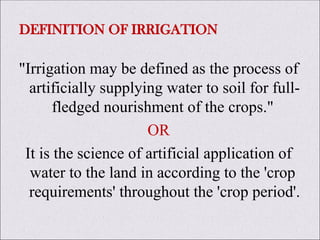irrigation engineering introduction of various parts etc
- 1. • As quality water is a scarce commodity, it is imperative to make best use of available water by developing and adopting suitable technologies of proper and efficient water management. • For this, it is important to have knowledge about irrigation water from its source to ultimate destination i.e. plant.
- 2. DEFINITION OF IRRIGATION "Irrigation may be defined as the process of artificially supplying water to soil for full- fledged nourishment of the crops." OR It is the science of artificial application of water to the land in according to the 'crop requirements' throughout the 'crop period'.
- 3. NECESSITY OF IRRIGATION IN INDIA • Scanty Rainfall irrigation works may be constructed at the places where quantity of water is available and we can convey the water to such areas where there is deficiency of water. • Non-Uniform Rainfall The rainfall is not uniform at all the zones. • Increasing Yield in Dry Farming Agriculture which deals with rainfall only is called dry farming.
- 4. • Practicing Crop Rotation To bring in rotation of crops, i.e. if we want that the more number of crops should be rotated then there, will be need of irrigation water. • Controlled Water supply (a) It can save the crops from drying during short duration droughts. (b) It washes out or dilutes salts in soil. (c) It cools the soil and also the atmosphere and makes more favorable environment for healthy plant growth.
- 5. Benefits of irrigation • Increase in food production • flood protection • Cultivation of cash crops • Elimination of mixed cropping • Addition to the wealth of the country • Hydroelectric power • Water supply • Inland navigation • Improvement of communication • Canal plantations • Improvement of ground water storage
- 6. ill Effects of Irrigation (a) Wasteful use of water (b) Water logging (c) Soil degradation in irrigated areas (d) Contamination of water with harmful substances (e) Damp climate and Ecological imbalances ( f ) Mosquitoes breeding.
- 7. HISTORY OF DEVELOPMENT OF IRRIGATION IN INDIA • The principal irrigation practice of the ancient times was diverting the flow of springs and streams with temporary barriers constructed across them and irrigating the adjoining fields. • modern well designed large scale irrigation systems were developed mainly after the 18th century. Irrigation technology made rapid strides in the 20th century. • After independence, a massive effort was launched by Government of India to develop several dam reservoirs and canal networks.
- 8. TYPES AND SOURCES OF IRRIGATION








